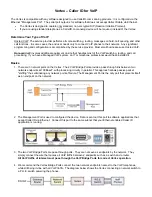
Vertex Setup Instructions
1. Refer to Figs. 1-4 to decide which connection diagram best matches your VoIP Network architecture.
2. Make Vertex connections when no VoIP calls are in progress and internet traffic is at a minimum.
Note that the Vertex will not pass a Gigabit connection.
If the Vertex is placed between 2 Gigabit endpoints,
reboot each device to allow automatic negotiation to 100BaseT. Refer to troubleshooting below.
3. Power-up the Vertex and wait until power light remains steady on. The unit will attempt to negotiate DHCP in an
effort to automatically obtain an IP address.
4. Check the other lights on the front panel. Amber lights on all three channels should be steady on, indicating a
network connection. If any amber light is not on, refer to troubleshooting below. The green lights on each
channel should flash, indicating data packets detected.
5. Close any software application on this computer that is meant to interface with the Vertex. For example, if you
are running a Caller ID enabled POS or Taxi Dispatch application on this computer, close it now.
6. Download and install the Vertex Configuration Tool (VCT) at
www.VCT.CallerID.com
.
7. Launch VCT. Upon startup, VCT must find the Vertex hardware. If the hardware is not found, turn off any third-
party Firewalls or virus checking programs, re-check Ethernet connections, and try again.
8. Once the hardware is detected, select “Yes” to load parameters from the Vertex.
9. VCT will prompt you to run the Setup Wizard.
Run the Wizard and follow all steps carefully
. When
completed, exit VCT.
10. Set the appropriate parameters within your software application to enable Caller ID pop-up screens.
Setup Troubleshooting
Issue:
Vertex Configuration Tool (VCT) will not detect the Vertex hardware.
Solutions
:
A. Check the Vertex Management Port lights. The amber light must be on and the green light flashing.
B. Turn off any 3rd party Firewalls (i.e. Norton, McAfee, Trend Micro, etc.).
C. If DHCP on the router is enabled, re-boot Vertex hardware in an attempt to negotiate DHCP.
D. Check the router DHCP table to determine whether the Vertex is listed. If shown, UDP broadcasts may be
blocked by a network appliance. Ping the address listed. If the Ping is successful, go to step F.
E. If DHCP on the router is disabled, try to Ping the Vertex at the default IP address of 192.168.1.90.
F. If Pinging the device is successful, you may have to use
File/Connection Manager
in VCT to communicate
via unicast. In order to use the VCT Wizard via unicast, follow the same instructions as "S
etting up Vertex
for a VPN" under Troubleshooting, at
www.VCT.CallerID.com.
Issue:
One or both amber lights on the VoIP bridge ports are not steady on. Note, both amber VoIP bridge ports
must be steady on for the Vertex to operate correctly.
Solutions
:
A. If you are placing the Vertex VoIP bridge ports between 2 Gigabit endpoints, both endpoints may need to be
re-booted to auto negotiate to 100BaseT. If re-boot does not create a network connection, the port
connected to the Vertex on one endpoint will need to be configured to 100BaseT.
B If the network connection is working properly and one or both amber lights are still not on steady, try
connecting the Vertex to another location closer to the VoIP phones. If the problem still exits, refer to "Amber
Lights not Coming On or Flashing", under Troubleshooting, at
www.VCT.CallerID.com.
Technical Support 770.263.7111
8:30 am - 5:00 pm, M-F, EST
[email protected]
(Include Serial Number of Device)
CallerID.com
5680 Oakbrook Pkwy. #150
Norcross, GA 30093
USA




